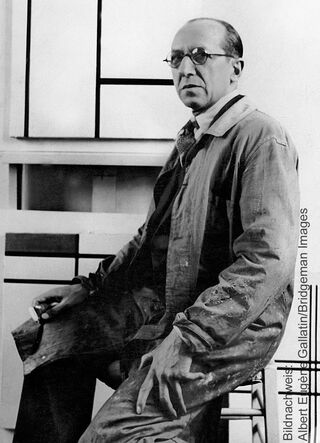Wall clock "Composition in Red, Blue, Yellow and Black"
Wall clock "Composition in Red, Blue, Yellow and Black"
Quick info
glass | quartz movement | size 30 x 30 x 2 cm (h/w/d) | shipped without batteries
Detailed description
Wall clock "Composition in Red, Blue, Yellow and Black"
A reinterpretation of a classic, this wall clock is designed to suit modern living spaces. Made of glass, with silent quartz movement. AA batteries are not included. Size 30 x 30 x 2 cm (h/w/d).
Customer reviews
Das bestellte Produkt ist schnell geliefert worden.
Ein hervorragendes Kunstobjekt, das aus meiner gesamten Uhrensammlung heraussticht! Großartig!
Sehr schnelle Erledigung des Auftrages, das Produkt entspricht umfänglich meinen Erwartungen.
Sieht sehr gut aus, alles wie beschrieben
Vielen Dank für das "Schmuckstück". Ich bin mit der Abwicklung vollumfänglich zufrieden. Auch der Zustellungswunsch wurde berücksichtigt.

About Piet Mondrian
1872-1944
It is hard to imagine that Piet Mondrian's strictly geometric compositions had their origins in painterly, filigree landscape studies. At the age of 20, as a student of the Art Academy in Amsterdam, he was drawn to Impressionism. In the neutral Netherlands, he was spared the turmoil of the First World War for a long time and was able to follow his inspiration and theosophical studies. There the first Fauvist and Neo-Impressionist elements appeared in his paintings.
In Paris, which he visited for the first time in 1912, he took part in several "Salons des Indépendants", where he was influenced by the cubism of Georges Braque and Pablo Picasso. Mondrian for example reduced the lines of a tree until the form of the tree is barely discernable and black, orthogonal bars divided the picture surface and becomes secondary to the overall composition of vertical and horizontal lines, he filled the spaces in between with white and primary colours.
Because of his profound knowledge of abstraction, he co-founded the painter, designer and architect group "De Stijl" in 1917 - the Dutch counterpart to the German group "Bauhaus". In his paintings, everything should be in balance, the depth effect should disappear so that "pure reality" remains.
Mondrian's visionary style left clear traces in art, design and architecture, also in New York, where the artist finally emigrated in 1940.
Collective term for the painters and sculptors of the 20th century, such as Pablo Picasso, Salvador Dalí, Joan Miró, Marc Chagall and others, whose works are the most recognized in our times.


